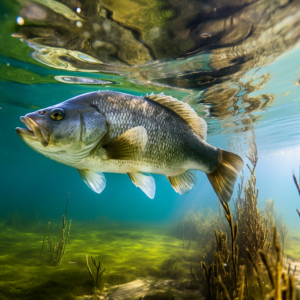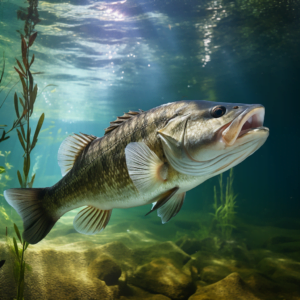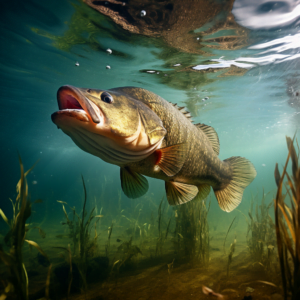So, you’re out on a fishing trip and you manage to catch yourself a nice, big largemouth bass. Now, the question arises – is it really worth it to eat this fish? Well, let’s take a closer look at the advantages and disadvantages, shall we?
Largemouth bass is a popular game fish and can provide a delicious meal if prepared correctly. The flesh is firm and tender, with a mild flavor that isn’t too overpowering. Plus, it’s a lean source of protein and packed with essential nutrients. However, there are a few things to consider before taking a bite.
Firstly, largemouth bass from polluted waters can contain high levels of mercury and other contaminants. It’s important to know where the fish was caught and ensure it comes from clean, safe waters. Additionally, the size of the bass matters – bigger, older fish tend to accumulate more toxins in their flesh. So, if you’re thinking about eating a largemouth bass, it’s best to choose smaller, younger ones.
In the end, whether eating largemouth bass is worth it or not depends on your personal preferences and circumstances. If you have access to clean waters and are mindful about the size and age of the fish, it can be a tasty and nutritious meal. However, if you have concerns about contaminants or would rather practice catch and release for conservation purposes, there are plenty of other fish in the sea (literally) that may be a better option. Stay tuned for more information in the article to help you make a well-informed decision.
Overview of largemouth bass
Largemouth bass, scientifically known as Micropterus salmoides, is a popular freshwater fish species that is valued by anglers and seafood enthusiasts alike. This article aims to provide an analysis of the pros and cons of consuming largemouth bass, taking into account its physical characteristics, habitat and distribution, ecological importance, nutritional value, preparation methods, flavor and texture, potential risks and concerns, cultural and regional perspectives, sustainable fishing practices, alternative fish options, personal choice and ethical considerations.
Physical characteristics of largemouth bass
Largemouth bass are known for their distinctive appearance, characterized by a large mouth that extends past their eyes. They have a compressed body shape, with the upper jaw extending beyond the eye, and are typically olive green in color, often with a dark, horizontal stripe along their sides. These fish can grow to impressive sizes, with some individuals reaching lengths of over two feet and weighing more than 20 pounds.
Habitat and distribution
Largemouth bass is native to North America and is commonly found in freshwater habitats such as lakes, rivers, and ponds. They thrive in areas with abundant vegetation, as this provides cover for their ambush hunting style. Largemouth bass can tolerate a wide range of water temperatures but prefer warm waters. They are primarily found in the southern and eastern regions of the United States, although they have been introduced to various other parts of the world due to their popularity as a game fish.
Ecological importance of largemouth bass
Largemouth bass play a crucial role in the ecosystems they inhabit. As predators, they help to control the population of smaller fish, contributing to the overall balance of aquatic ecosystems. They are known to feed on a variety of prey, including smaller fish, frogs, crayfish, and insects. Additionally, largemouth bass serve as an important game fish for recreational anglers, supporting local economies and promoting outdoor activities.
Nutritional value of largemouth bass
Macronutrient content of largemouth bass
Largemouth bass is a lean source of protein, with approximately 20 grams of protein per 100 grams of cooked fish. It is also low in fat, containing only around 2 grams of fat per 100 grams. The fat content primarily consists of healthy omega-3 fatty acids, which are essential for heart health and brain function. Largemouth bass is a good source of various vitamins and minerals, including vitamin B12, selenium, and potassium.
Micronutrients found in largemouth bass
Largemouth bass is rich in micronutrients that are vital for maintaining overall health and well-being. It contains significant amounts of vitamin D, which is important for bone health, immune function, and the absorption of calcium. Other micronutrients present in largemouth bass include vitamin A, vitamin E, and various B vitamins, all of which play essential roles in various bodily functions.
Health benefits of consuming largemouth bass
Incorporating largemouth bass into your diet can offer several health benefits. The high protein content helps in building and repairing tissues, improving muscle strength and aiding in weight management. The omega-3 fatty acids found in largemouth bass have anti-inflammatory properties and are beneficial for heart health. They are also believed to contribute to cognitive function and may reduce the risk of certain chronic diseases, such as cardiovascular disease.
Preparing largemouth bass for consumption
Cleaning and filleting techniques
Before cooking largemouth bass, it is important to properly clean and fillet the fish. Start by removing the scales, either by using a fish scaler or scraping the fish against the direction of the scales with a knife. Then, make a long incision from the anus to the base of the gills and carefully remove the entrails. Rinse the cavity thoroughly with cold water. Next, use a sharp knife to fillet the fish, ensuring you remove the skin and any remaining bones. Take care to discard any dark fatty tissue, as this can impart a fishy taste.
Seasoning and marinating options
To enhance the flavor of largemouth bass, consider marinating the fillets before cooking. A simple marinade can consist of lemon juice, olive oil, garlic, and herbs such as parsley or dill. This will help to tenderize the meat and add a subtle citrusy flavor. Alternatively, dry rubs can be used, combining various herbs and spices such as paprika, black pepper, and thyme. Allow the fish to marinate for at least 30 minutes to allow the flavors to penetrate the meat.
Cooking methods for largemouth bass
Largemouth bass can be cooked using various methods, depending on personal preference and desired outcomes. Grilling is a popular option, as it imparts a smoky flavor while allowing the fillets to remain moist and tender. Baking or roasting is another viable method, with the fish being placed in the oven with a selection of herbs, spices, and vegetables for added flavor. Pan-searing or frying is a quick and easy technique that results in a crispy exterior and moist interior.
Flavor and texture of largemouth bass meat
Taste profile of largemouth bass
Largemouth bass has a mild yet distinctive flavor that is often described as similar to other freshwater fish species. When prepared correctly, the meat possesses a slightly sweet and nutty taste, with a hint of earthiness. The flavor can vary depending on the habitat and diet of the fish, with individuals caught in different regions offering subtle differences in taste. The overall flavor profile makes largemouth bass versatile and adaptable to a wide range of culinary preparations.
Texture characteristics of the meat
The texture of largemouth bass meat is another appealing aspect. When cooked properly, the flesh is firm, moist, and flaky. It has a delicate yet substantial texture that lends itself well to various cooking methods. This versatility allows largemouth bass to be used in a variety of dishes, from pan-seared fillets to fish tacos or even being incorporated into chowders and stews.
Comparison to other commonly consumed fish
In comparison to other commonly consumed fish, largemouth bass holds its ground in terms of flavor and texture. It can be likened to other freshwater fish species such as trout or perch in terms of taste, with a mild and slightly sweet profile. In terms of texture, largemouth bass falls somewhere between delicate white fish like sole or flounder and denser, meatier fish like salmon or tuna. Its versatility in flavor and texture makes it a valuable addition to any seafood lover’s repertoire.
Potential risks and concerns
Mercury and other contaminants
One potential risk associated with consuming largemouth bass is the presence of mercury and other contaminants in the fish. Mercury is a toxic metal that can accumulate in the tissues of fish over time, particularly in larger, older individuals. Consuming fish contaminated with mercury can pose health risks, especially for pregnant women, nursing mothers, and young children. It is therefore important to be aware of advisories and guidelines regarding fish consumption in your area, as well as taking steps to minimize exposure to mercury and other contaminants.
Environmental impacts of bass consumption
Another concern regarding largemouth bass consumption is the potential impact on the environment. Despite being a popular game fish, largemouth bass is considered an invasive species in some regions. Introducing largemouth bass into non-native habitats can disrupt local ecosystems, as they may outcompete and prey upon native fish species. Additionally, overfishing of largemouth bass can deplete populations and lead to imbalances in aquatic ecosystems. Considering the environmental consequences is crucial when making decisions about consuming largemouth bass.
Regulations and advisories
To mitigate the risks associated with largemouth bass consumption, many regions have implemented regulations and advisories. These guidelines may include restrictions on the size and number of largemouth bass that can be harvested, as well as recommendations for limiting consumption in certain populations, such as pregnant women. It is important to stay informed about local regulations and advisories to ensure responsible harvesting and consumption of largemouth bass.
Cultural and regional perspectives
Popularity of largemouth bass in different cuisines
Largemouth bass is a prized ingredient in certain cuisines, particularly in regions where freshwater fishing is prevalent. In the southern United States, largemouth bass is a staple in traditional Southern cuisine, often served fried alongside hush puppies and coleslaw. In Japan, largemouth bass is regarded as a delicacy and is commonly used in sushi and sashimi preparations. Furthermore, largemouth bass is gaining popularity in various international cuisines, as its mild flavor and adaptable nature make it suitable for a wide range of dishes.
Traditional recipes featuring largemouth bass
In addition to being valued in certain cuisines, largemouth bass has a rich tradition of being prepared in various ways. In the southern United States, it is often fried or used in fish stews and gumbo. In Japan, largemouth bass may be marinated in soy sauce and grilled, served alongside rice and miso soup. In both cases, the fish is prepared to highlight its natural flavors and complement complementary ingredients, showcasing the versatility and adaptability of largemouth bass in traditional recipes.
Fishing as a cultural activity
The act of fishing for largemouth bass itself holds cultural significance in many societies. For generations, fishing has been a way for families and communities to bond and connect with nature. It provides an opportunity to experience the outdoors, appreciate the beauty of water bodies, and develop a deeper understanding of the ecosystem. Fishing for largemouth bass can be an enjoyable pastime, fostering a sense of community and preserving cultural traditions.
Sustainable fishing practices
Conservation efforts for bass populations
Given the ecological importance of largemouth bass, conservation efforts are essential to ensure their sustainability. Fishery management practices, such as enforcing catch limits and implementing size restrictions, help to protect largemouth bass populations from overfishing. Additionally, habitat restoration efforts, such as creating and maintaining suitable vegetation and water quality, contribute to the conservation of largemouth bass and their ecosystems.
Catch and release practices
Catch and release practices, where anglers release largemouth bass back into the water after catching them, also contribute to sustainability. This practice allows fish to reproduce and maintain healthy populations. Catch and release should be done carefully and responsibly, ensuring that fish are handled properly to minimize stress and injury. By practicing catch and release, anglers can continue to enjoy the thrill of fishing while ensuring the long-term viability of largemouth bass populations.
Supporting responsible fishing
Supporting responsible fishing practices is crucial to safeguard the future of largemouth bass and other fish species. This can be done by purchasing seafood from sustainable sources, such as those certified by organizations like the Marine Stewardship Council (MSC) or the Aquaculture Stewardship Council (ASC). These certifications ensure that the fishery or aquaculture operation follows strict environmental and social standards. By making informed choices and supporting sustainable fishing, individuals can actively contribute to the conservation of largemouth bass and promote responsible seafood consumption.
Alternative options for fish consumption
Sustainable fish alternatives
For individuals who are reluctant to consume largemouth bass due to concerns about sustainability or environmental impact, there are alternative fish options available. Sustainable choices include fish species that are abundant, well-managed, and have minimal impact on ecosystems. Some examples of sustainable fish alternatives include Alaskan salmon, Pacific cod, Atlantic mackerel, and U.S. farmed trout. Researching and choosing sustainable fish options helps to support the long-term health of fish populations and marine ecosystems.
Healthier fish choices
If health considerations are paramount in your decision-making process, there are fish species that are known for their nutritional benefits. Fatty fish, such as salmon, trout, and sardines, are rich in omega-3 fatty acids, which are beneficial for heart health. These fish also have low levels of mercury, making them safe for regular consumption. Other healthful options include tilapia, catfish, and shellfish like shrimp and mussels. These fish provide a good balance of nutrients while reducing potential risks associated with contaminants.
Exploring diverse seafood options
For those seeking variety in their seafood choices, exploring different fish species can be a rewarding experience. The world’s oceans are teeming with an incredible diversity of fish, each with its own unique flavors and textures. Trying new options such as mahi-mahi, black cod, or snapper can introduce new tastes and culinary possibilities. Additionally, exploring regional cuisines that feature lesser-known fish species can open up a world of gastronomic delights. By expanding your seafood horizons, you can enjoy the benefits of diverse and sustainable fish consumption.
Personal choice and ethical considerations
Balancing personal preferences and sustainability
When deciding whether to eat largemouth bass, it is important to strike a balance between personal preferences and sustainability concerns. Some individuals may value the taste and culinary versatility of largemouth bass, making it a worthwhile choice for them. However, it is crucial to consider the potential ecological impact and health risks associated with consuming largemouth bass. By being mindful of sustainability and making informed choices, you can align your personal preferences with responsible and ethical consumption.
Ethical concerns related to fish consumption
Ethical concerns surrounding fish consumption encompass various aspects, including the treatment of fish, overfishing, and the broader impact on ecosystems. Some individuals may choose to avoid eating fish altogether due to ethical concerns related to animal welfare. Others may prioritize supporting sustainable fishing methods and protecting marine biodiversity. Understanding your own ethical stance on fish consumption and being aware of the environmental and social implications can help guide your decision-making process.
Making informed decisions about eating largemouth bass
Ultimately, the decision of whether or not to eat largemouth bass is a personal one that should be based on a variety of factors. By considering the ecological importance of largemouth bass, its nutritional value, the potential risks and concerns, cultural perspectives, sustainable fishing practices, and alternative options, you can make an informed decision that aligns with your values and preferences. It is important to remain open-minded, continuously seek information, and adapt your choices as new knowledge and understanding emerge.
Conclusion
In conclusion, the decision of whether or not to eat largemouth bass depends on a range of factors that are unique to each individual. Largemouth bass offers several advantages, such as its nutritional value, versatile flavor and texture, and cultural significance. However, it also presents potential risks and concerns regarding contaminants, impact on ecosystems, and ethical considerations. By carefully considering the pros and cons, with an emphasis on sustainability and health, you can make an informed decision that takes into account your personal values and preferences. Ultimately, the answer to the question, “Is eating largemouth bass worth it?” lies in your hands.




